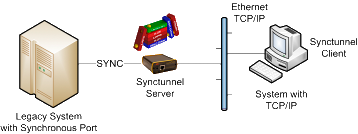HDLC over TCP/IP
High-Level Data Link Control (HDLC) is a bit-oriented synchronous data link layer protocol developed by the International Organization for Standardization (ISO), based on IBM’s SDLC.
The framing part of the HDLC standard specifies how transmission frames are delimited, how data are transmitted transparently and how error detection is performed. Traditionally a communication chip handles these features while higher layer protocols, specifically link procedures (e.g. LAPB) have been handled by software. The HDLC framing is used by many devices and is what we call Raw Mode HDLC.
LayGO™ PXSe Synctunnel
Using the LayGO™ PXSe as an synchronous (e.g. HDLC) gateway, the user can access a synchronous device as a TCP/IP capable device. The LayGO™ PXSe acts as a synchronous to TCP/IP gateway, taking care of all the necessary conversions. The user just reads or writes to a TCP/IP port.

Note that in this case the LayGO™ Protocol Stack is still used internally in the PXSe, but the user need not to be aware of this fact. All details of the synchronous protocol are handled internally by the synctunnel firmware.
[Last updated April 10th, 2024]